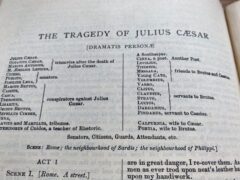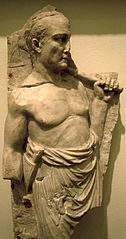
When I was in high school during the last century, students studied Shakespeare’s Julius Caesar in 10th grade. Besides grappling with impossible language and syntax, we encountered the soothsayer’s warning in Act 1, Scene 2.
Caesar and his advisors make their way through a crowd on a festival day, perhaps the festival of Lupercalia, an annual February event to ward off evil spirits and release fertility for the coming planting season.

According to Shakespeare’s scene, as Caesar walks through the crowds, he hears someone call: Caesar! — the beginning of some snappy dialogue.
Caesar: Ha! Who calls?
Casca: Bid every noise be still: peace yet again!
Caesar: Who is it in the press that calls on me? I hear a tongue, shriller than all the music, Cry ‘Caesar!’ Speak; Caesar is turned to hear.
Soothsayer: Beware the ides of March.
Caesar: What man is that?
Brutus: A soothsayer bids you beware the ides of March.
Caesar: Set him before me; let me see his face.
Cassius: Fellow, come from the throng; look upon Caesar.
Caesar: What say’s thou to me now? Speak once again.
Soothsayer: Beware the ides of March.
Caesar: He is a dreamer; let us leave him: pass.
In fact, Caesar should have paid closer attention, because he was assassinated on the Ides of March, or March 15, 44 BCE by men who thought Caesar was taking too much power. But who was the soothsayer, and how would he know?

Soothsayers were minor priests who read the entrails of sacrificed animals to predict the future. Like many men, Caesar had a personal soothsayer, Spurinna. And on February 15th, Spurinna sacrificed a bull. The bull, according to Spurinna, had no heart.
But there’s more to it than that. Spurinna paid attention to Rome’s political climate. He knew there was strong opposition to Caesar, and that if the rebels were going to act, it would be before Caesar left on a military campaign on March 18.
Spurinna advised Caesar to beware for the next 30 days. Then the day before the ides of March, birds pursued a wren carrying a sprig of laurel in its beak into the Senate House and killed it. And there were dreams.
The day before he died, Caesar dreamed he soared above the clouds and even joined hands with Jupiter, leader of the gods. Caesar’s wife Calpurnia dreamed he was murdered and begged her husband not to go to the senate.
But Caesar wasn’t a man to be swayed by superstition. Legend has it, Caesar told Spurinna his prophecy was wrong, to which the soothsayer reminded him the day wasn’t over yet.

When Caesar got to the Senate, 61 former friends stabbed him 23 times. It would have been a melee among well-trained warriors with lots of blood on the floor.
I suppose the moral of the story is to listen to your soothsayer.
Ide, by the way, means divide. In the lunar calendar that preceded the Julian calendar, dates related to the phases of the moon. The new moon was called the Kalends on the first day of the month. The first quarter moon was called Nones. The full moon was the Ide.
In March, May, July, and October, it was the 15th day of the month. In January, February, April, June, August, September, November, and December, the ides fell on the 13th day.
🏛🏛🏛
Bust of Julius Caesar bronze head on later marble bust at Uffizi Gallery by Sebastien ambit; l
Murder of Caesar by Vincenzo Camuccini
“Professing Faith: If Julius Caesar had been more religious he might have survived.” Redlands Daily Facts. Mar 16, 2016.
Phil Edwards. “6 Myths about the Ides of March and the Killing of Caesar.” Vox. Mar. 15, 2017.
Nicol Valentin. “Liver + Toast = One Really Bad Day for Caesar.” Medium. Mar. 11, 2019.

Sandra Wagner-Wright holds the doctoral degree in history and taught women’s and global history at the University of Hawai`i. Sandra travels for her research, most recently to Salem, Massachusetts, the setting of her new Salem Stories series. She also enjoys traveling for new experiences. Recent trips include Antarctica and a river cruise on the Rhine from Amsterdam to Basel.
Sandra particularly likes writing about strong women who make a difference. She lives in Hilo, Hawai`i with her family and writes a blog relating to history, travel, and the idiosyncrasies of life.

